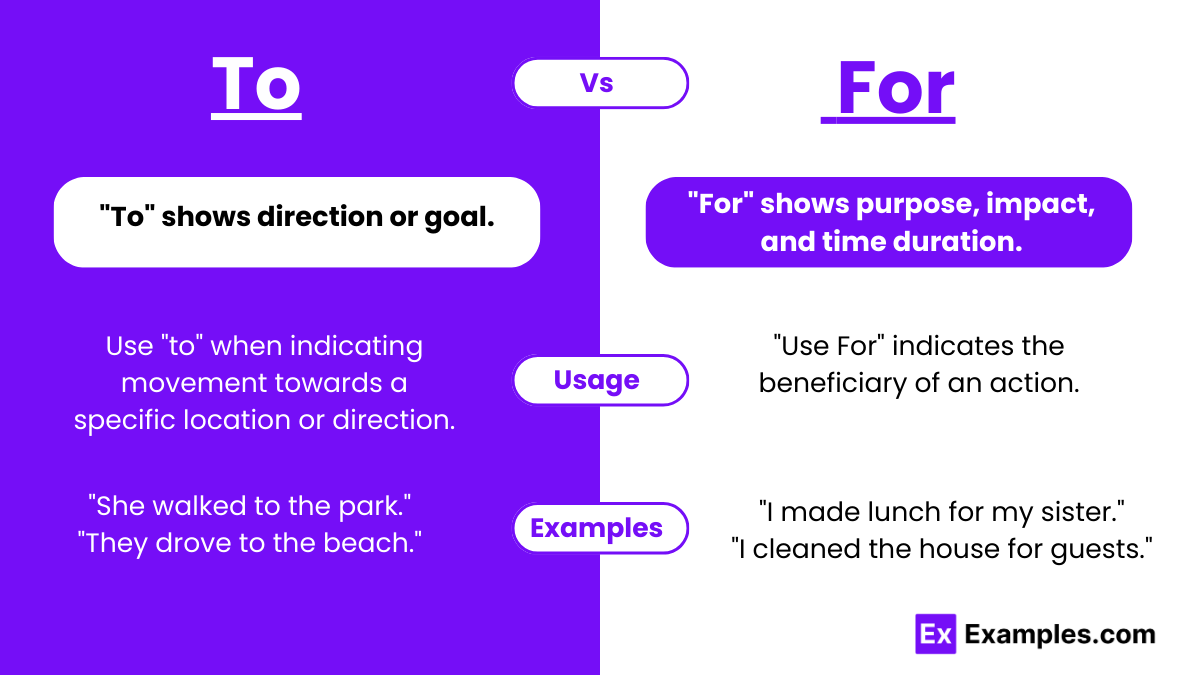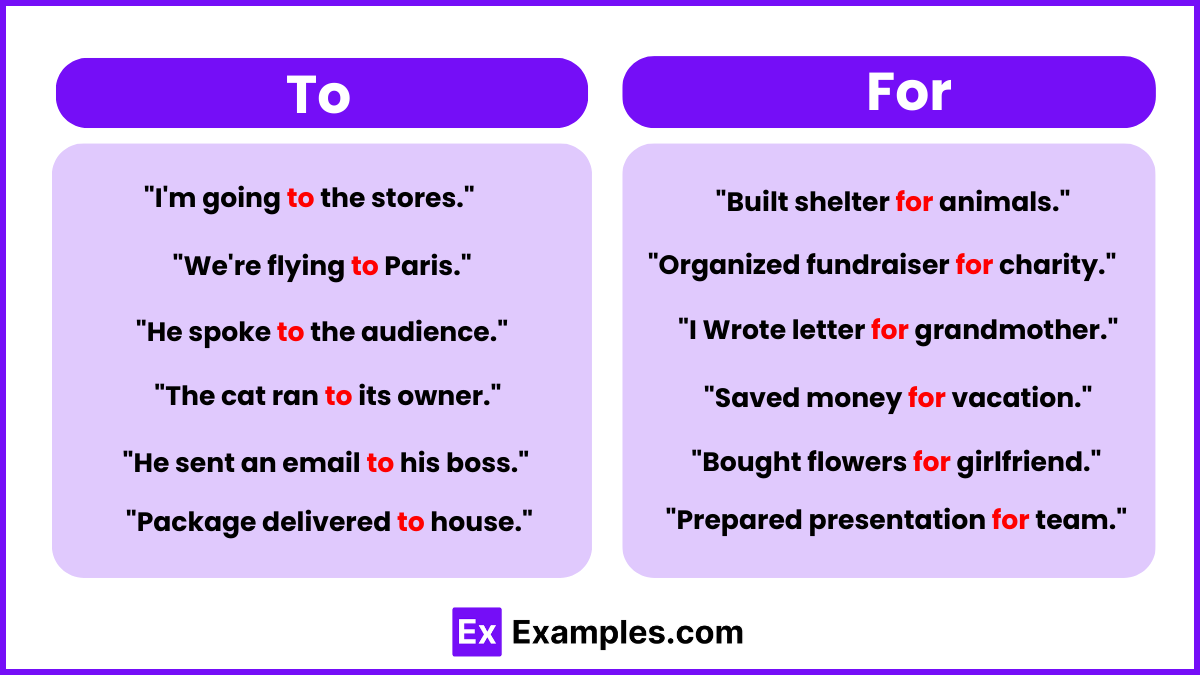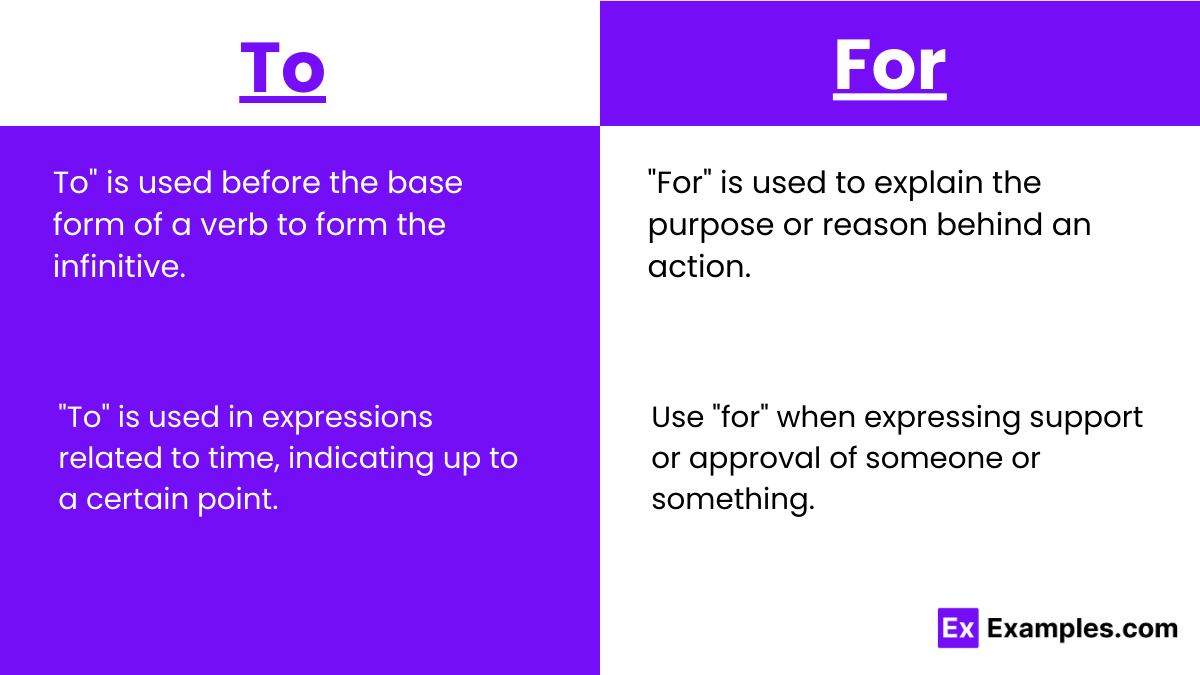To vs For – Examples, Differences, Usage, PDF
In the vast landscape of English grammar, the prepositions “to” and “for” stand as pivotal elements, subtly guiding the direction and meaning of our sentences. These small yet mighty words are the unsung heroes of clarity and coherence in communication, appearing in almost every sentence we craft. The challenge, however, lies in their deceptively similar uses, which can confound even the most seasoned speakers of English. This article aims to shed light on the distinct roles that “to” and “for” play in the English language, offering students a clear and concise guide to mastering their usage.
The frequent mix-up between “to” and “for” is more than a mere grammatical hiccup; it represents a common obstacle on the path to fluent and effective communication. Recognizing the unique contexts and functions of these prepositions is essential for constructing sentences that convey the intended message with precision. With a focus on practical examples and common pitfalls, this article seeks to unravel the intricacies of “to” and “for,” empowering students to use these prepositions with confidence and accuracy in their everyday writing and conversation.
To and For – Meanings
To: The preposition “to” primarily indicates direction or movement towards a specific destination, point in time, or end goal. It is used to express purpose, intention, or a resulting state. “To” often appears in expressions related to travel, actions aimed at achieving something, or transitions from one state to another. It also forms part of infinitive verbs, marking the action or intention (e.g., to run, to write).
For: The preposition “for” is used to indicate the purpose of an action, the benefit or detriment to someone or something, and the duration of time. It often highlights a relationship of function, favor, or support. “For” can also suggest on behalf of, in favor of, or because of. It is frequently used to explain why something is done, the intended recipient of an action, or the cause behind a particular event or condition.
Summary
The prepositions “to” and “for” serve distinct purposes in English, guiding us through nuances of direction, purpose, and relationships. “To” primarily denotes movement towards a destination, a point in time, or an objective, and is integral in forming infinitive verbs, signaling intention or potential actions. In contrast, “for” emphasizes the reason behind an action, the beneficiary of an activity, or the duration over which something occurs. Understanding the unique applications of “to” and “for” is crucial for conveying precise meanings and building coherent sentences, whether it’s indicating direction with “to” or expressing purpose and benefit with “for.”
Difference Between To and For
The distinction between “to” and “for” is a subtle yet significant aspect of English grammar, each serving a unique function in conveying direction, purpose, and relation. Below is a table highlighting 10 key differences to help clarify their usage:
| Aspect | To | For |
|---|---|---|
| Direction | Indicates movement towards a place or point. | Not typically used to indicate direction. |
| Purpose | Used before a verb to form the infinitive, showing intention. | Indicates the reason or purpose behind an action. |
| Beneficiary | Less commonly used for the beneficiary. | Specifies who or what benefits from an action. |
| Duration | Can denote a point in time. | Indicates the duration of time. |
| Function | Often part of verbal expressions. | Highlights the function or use of something. |
| Relationship | Suggests a direction or a limit. | Suggests a beneficial relationship. |
| Objective | Implies an aim or end point of an action. | Used to explain why something is done. |
| Infinitive Form | Essential in forming infinitive verbs (to + verb). | Does not form infinitive verbs. |
| Exchange | Can imply an exchange or a response. | Implies doing something on behalf of someone or something. |
| Time | “To” is less common in the context of time, except in expressions like “to this day.” | More commonly used to specify a period of time, as in “for years.” |
Understanding these differences is key to mastering the nuanced use of “to” and “for” in English, enabling more precise and clear communication.
Examples of To and For
Examples of “To”
- Direction: She is heading to the library.
- Purpose (Infinitive Verb): He wants to learn Spanish.
- Time: We will return to work at 2 PM.
- Relation/Comparison: This gift is nothing compared to what you gave me.
- Opinion: I am to believe that honesty is always the best policy.
Examples of “For”
- Beneficiary: This present is for you.
- Purpose/Reason: We use a spoon for eating soup.
- Duration: I have lived here for five years.
- Function/Use: This tool is used for cutting.
- Support/Favor: I am for the new environmental policy.
When to Use To and For
Understanding when to use “to” and “for” is essential for clarity and precision in English communication. Here are some guidelines:
When to Use “To”:
- Direction and Destination: Use “to” when indicating movement towards a specific location or direction. Example: “She is going to the office.”
- Infinitive Form of Verbs: “To” is used before the base form of a verb to form the infinitive. Example: “I need to study tonight.”
- Indicating a Recipient: “To” is used when specifying a recipient of an action. Example: “Give the book to her.”
- Time: “To” is used in expressions related to time, indicating up to a certain point. Example: “The shop is open from 9 to 5.”
- Purpose or Intention: When expressing purpose or intention, “to” is used. Example: “To improve your health, consider exercising daily.”
When to Use “For”:
- Beneficiary: Use “for” when indicating who or what is receiving a benefit or is the intended recipient of an action. Example: “This gift is for Mark.”
- Purpose or Reason: “For” is used to explain the purpose or reason behind an action. Example: “I am saving money for a new car.”
- Duration: When indicating the duration of time, “for” is used. Example: “We’ve been waiting for two hours.”
- Function or Use: “For” can indicate the function or intended use of something. Example: “This tool is for cutting.”
- In Favor of: Use “for” when expressing support or approval of someone or something. Example: “Are you for or against this proposal?”
By considering these contexts and purposes, you can choose between “to” and “for” more confidently, enhancing your English language proficiency.
Common word pairings that use “To” and “For”
Understanding common word pairings with “to” and “for” can enhance your fluency and accuracy in English. Here are some frequent collocations:
Common Word Pairings with “To”:
- Listen to: “You should listen to the lecture for better understanding.”
- Speak to: “I need to speak to the manager about this issue.”
- Go to: “She goes to the gym every morning.”
- Belong to: “This book belongs to the library.”
- Reply to: “Please reply to the email as soon as possible.”
Common Word Pairings with “For”:
- Look for: “I’m looking for my keys. Have you seen them?”
- Apply for: “He is applying for a new job.”
- Wait for: “We have been waiting for the bus for twenty minutes.”
- Care for: “She cares for her sick grandmother every day.”
- Pay for: “You’ll need to pay for any damages caused.”
Using “To” and “For” with Purpose and Reasons
- To (Purpose): “I jog in the morning to clear my mind.” Here, “to” introduces the purpose of jogging.
- For (Reason): “We’re having a fundraiser for raising awareness.” In this case, “for” provides the reason for the fundraiser.
Using “Important To” and “Important For”
- Important To (Personal Significance): “Quality time with family is important to me.” This emphasizes personal value.
- Important For (Objective Necessity): “A balanced diet is important for good health.” This highlights a general necessity or requirement.
Using “To”and”For” with Receiving Something
- To (Direction/Recipient): “The award was presented to the winner.” “To” specifies the direction of the action towards the recipient.
- For (Purpose/Benefit): “This scholarship is for students facing financial difficulties.” “For” indicates the purpose or benefit associated with receiving the scholarship
Exercise on “To” and “For”
- I need to talk __ you about the upcoming project meeting.
- This manual is intended __ beginners who are new to programming.
- We’re going __ the beach this weekend for some relaxation.
- Can you please send this package __ Mr. Johnson on the third floor?
- She’s been studying hard __ pass her final exams.
- These instructions are crucial __ ensuring the machine operates safely.
- He donated a generous sum __ the charity event last night.
- Are you coming __ dinner at my place tomorrow?
- This guide is __ anyone interested in learning about digital photography.
- She’s saving money __ buy a new laptop next month.
FAQs
What Is the Difference Between To and For When Communicating the Reason for or Purpose of Something?
The difference lies in context: “to” often introduces an action or intention (I went to the store to buy milk), while “for” explains the reason behind an action (I bought milk for the recipe).
Is It Used To or Used For?
“Used to” describes past habits (I used to jog every morning), while “used for” indicates the purpose or function of something (This tool is used for cutting).
What Is the Rule of Using To and For?
The rule is based on context: use “to” primarily for direction, destination, or intention (go to the park, to learn), and “for” for purpose, benefit, or duration (for the party, for a year).
Am I Supposed To or Am I Supposed For?
The correct form is “am I supposed to,” which is used to inquire about obligations, expectations, or correct actions (Am I supposed to attend the meeting?).





